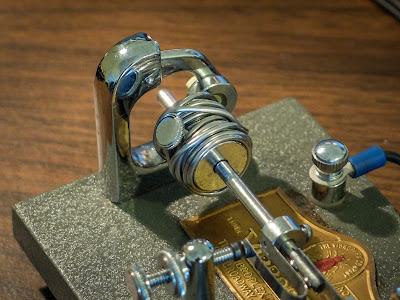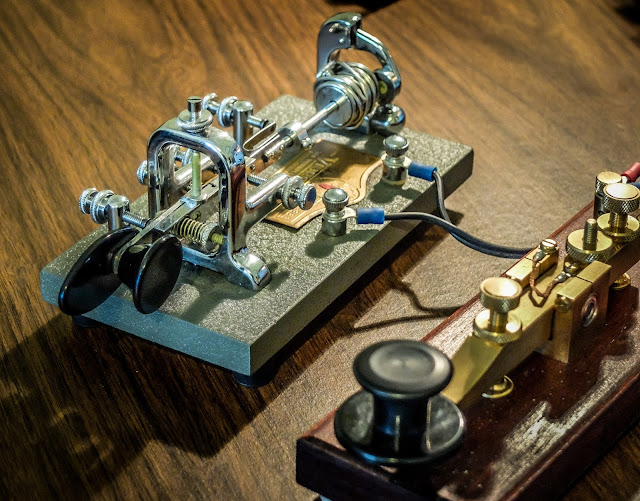 Don’t Bug OUT when hearing a Vibroplex semi-automatic key
Don’t Bug OUT when hearing a Vibroplex semi-automatic key
Vibroplex Bug Morse Keys
Since starting to work CW on-air a few months back I became familiar with the sound of other operators using Vibroplex Bug telegraph keys. I have been curious to try one of these semi-automatic keys even though I know that they are not recommended for new operators.
 |
| Vibroplex Original Semi-automatic Bug |
The Bug uses a sprung pendulum to automatically send DITS. The action of moving the lever to the right starts the pendulum in motion and it creates evenly timed DITS automatically. DAHS are created by manual timing moving the key to the left. Using the key requires quite a bit more practice that using a straight key or paddles.
The Vibroplex semi-automatic Bug is considered a manual key by the SKCC (Straight Key Century Club) so it counts in SKCC contacts.
Used Bugs in decent working condition can often be had for under $70. This one was advertised as being "un-used new in box". Indeed, when I received it, it still had the shipping bumpers on the main spring and still had shipping grease. The glue on the nameplate had deteriorated and come loose and there was significant oxidation on the parts. This bug is a few decades old but that doesn't matter because Vibroplex bugs haven't changed much in design since 1907. The history of their creator, Horace Martin is interesting. He created the bug to help deal with his own degraded sending ability due to long hours operating a straight key as a renowned telegrapher.
Horace was a professional telegrapher so he designed the bug for professionals who sent at speeds well above what is normally used in amateur radio. The slowest speed this bug can send DITS without modification is about 25wpm and goes well above 40wpm.
As a beginning CW operator you will generally be well below that speed in your copy skills and likely your sending speed as well. But when experienced hams work you with a bug they will slow their DAHS down to your speed, however without special added weights there's not much they can do to slow down their DITS to your speed. This gives their FIST a unique sound. The DAHS are sent slowly but the DITS are zinging by. When you first hear this style your brain will not know how to interpret what you hear but give it some time and you will learn to copy them.
You can slow the Bug down by adding weight to the end of the pendulum. An inexpensive method is to wrap the weight with some solder. I've wrapped mine to bring it down to about 22wpm.
 |
| Wrap the pendulum weight with solder to slow it a bit |
Here is a little video letting you hear a bit of the cadence of the bug. Now I just received this thing today and I practiced with it for about 30 minutes before making this video so I'm no bug operator for sure but it will give you some idea of the bug "swing"...
Here is a video running through the keys to see if learning a Vibroplex messes up my ability to use a paddle with an electronic keyer The Vibroplex Bug next to a Kent Hand Key.  |
| Manual Morse Code Keys |
So don't "bug out" when you hear one of these on the air.
That's all for now
So lower your power and raise your expectations
73/72
Richard - N4PBQ














Excellent, Richard. Almost unbelievable that you only began operating CW in late August, and you’ve already graduated to a Bug! Also enjoyed your terrific photography.
73, Ron K5XK (Bella Vista, Arkansas)
Thanks Ron. I’m enjoying the journey. I worked a number of stations with the bug today and it required so much concentration that I caught myself holding my breath haha. Hate to pass out during a qso.
73/72 Richard n4pbq
Don’t mesh up the bug or you’ll work no-one. If one’s a singer on a bug and send everything without proper spaces between words no-one will understand it.
Beautifull bug you’ve got there !!
I agree Frank. I’m working on on my Bug fist. So far a couple of ops have already commented that they didn’t realize I was using a bug until I told them. Here is a practice session…
https://www.youtube.com/watch?v=BB_-zx6BFzk
Yes Hari Big Brother, those SMARTISTS who initiated the “millennium bug” criiss after ten year or so dominating the SECURITY development were now all taking early retirement and enjoying their LIVES.Those photoes in 7×6 were links that I created, when the originals were gone (I believe) so they were not there anymore. I would try to build in new linkage(s) when I got the time. Stay tunned.
HOLA, SOY UN TELEGRAFISTAJUBILADO , TENGO UN VIBROPLEX QUE HA CSTADO MUCHO AJUSTARLO, Y ESTADO BUSCANDO INFORMACION SOBREE CUAL ES EL RESORTE PRINCIPAL DEL VIBROPLEX, SI ALGUNA PERSONA, PUDIERA INFORMARME Y SI ES POSIBLE ENVIARME UNA IMAGEN DE EL ,POR EL INTERES A MI PREGUNTA, QUEDO A SUS ORDENES
perdon, aclaro mi mensaje anterior, si pudieran informarme cual es el resorte principal del vibroplex bug , y si fueran tan amables enviarme una imagen del mismo, por atencion a mi pregunta quedo a sus 0rdenmes
I’d like to purchase a good used “Bug”. Don’t have a lot of money. Been Ham 60 years. Thanks. LCS, WA5CBF